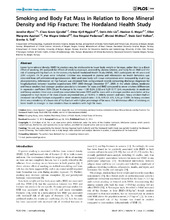| dc.description.abstract | Lower bone mineral density (BMD) in smokers may be attributable to lower body weight or fat mass, rather than to a direct effect of smoking. We analyzed the effects of smoking exposure, assessed by plasma cotinine, and body fat on BMD and the risk of subsequent hip fracture. In the community-based Hordaland Health Study (HUSK), 3003 participants 46–49 years and 2091 subjects 71–74 years were included. Cotinine was measured in plasma and information on health behaviors was obtained from self-administered questionnaires. BMD and total body soft tissue composition were measured by dual X-ray absorptiometry. Information on hip fracture was obtained from computerized records containing discharge diagnoses for hospitalizations between baseline examinations 1997–2000 through December 31st, 2009. In the whole cohort, moderate and heavy smokers had stronger positive associations between fat mass and BMD compared to never smokers (differences in regression coefficient (95% CI) per % change in fat mass = 1.38 (0.24, 2.52) and 1.29 (0.17, 2.4), respectively). In moderate and heavy smokers there was a nonlinear association between BMD and fat mass with a stronger positive association at low compared to high levels of fat mass (Davies segmented test, p<0.001). In elderly women and men, heavy smokers had an increased risk of hip fracture compared to never smokers (hazard ratio = 3.31, 95% CI: 2.05, 5.35; p<0.001). In heavy smokers there was a tendency of a lower risk of hip fracture with higher percentage of fat mass. The deleterious effect of smoking on bone health is stronger in lean smokers than in smokers with high fat mass. | en_US |

